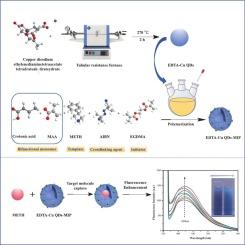基于EDTA-Cu量子点的分子印迹荧光传感器识别甲基苯丙胺。
IF 4.6
2区 化学
Q1 SPECTROSCOPY
Spectrochimica Acta Part A: Molecular and Biomolecular Spectroscopy
Pub Date : 2025-10-01
DOI:10.1016/j.saa.2025.127001
引用次数: 0
摘要
甲基苯丙胺(冰毒)是一种强效精神兴奋剂,具有很高的成瘾潜力,是世界上最普遍和最常被滥用的非法物质之一。因此,发展快速和精确的甲基苯丙胺检测方法对于执法和公共卫生监测至关重要。本研究首次利用EDTA-Cu量子点(EDTA-Cu QDs-MIP)构建了用于甲基苯丙胺荧光定量的分子印迹荧光传感器。该传感器在53 ~ 371 nM的浓度范围内呈线性响应,荧光光谱检测限(LOD)为20.6 nM。实际样品的验证证实了传感器的高精度,回收率在97.2至104.4%之间。该研究不仅拓宽了量子点在化学检测中的应用范围,而且为法医调查和现场筛选非法药物提供了一个强大的便携式平台。本文章由计算机程序翻译,如有差异,请以英文原文为准。

A molecular imprinted fluorescence sensor based on EDTA-Cu quantum dots for methamphetamine recognition
Methamphetamine (METH) is a potent psychostimulant with a high potential for addiction, ranking among the most prevalent and frequently abused illicit substances worldwide. Thus, the development of rapid and precise methodologies for METH detection is essential for law enforcement and public health monitoring. This study reported the first construction of a molecularly imprinted fluorescence sensor utilizing EDTA-Cu quantum dots (EDTA-Cu QDs-MIP) for the fluorescence quantification of methamphetamine. The sensor displayed a linear response within a concentration range spanning from 53 to 371 nM, achieving a limit of detection (LOD) equal to 20.6 nM through fluorescence spectroscopy. Validation with real-world samples confirmed the sensor's high accuracy, with recovery rates in the range from 97.2 to 104.4 %. This study not only broadens the scope of QDs in chemical detection but also introduces a strong and portable platform for forensic investigations and on-site screening of illicit drugs.
求助全文
通过发布文献求助,成功后即可免费获取论文全文。
去求助
来源期刊
CiteScore
8.40
自引率
11.40%
发文量
1364
审稿时长
40 days
期刊介绍:
Spectrochimica Acta, Part A: Molecular and Biomolecular Spectroscopy (SAA) is an interdisciplinary journal which spans from basic to applied aspects of optical spectroscopy in chemistry, medicine, biology, and materials science.
The journal publishes original scientific papers that feature high-quality spectroscopic data and analysis. From the broad range of optical spectroscopies, the emphasis is on electronic, vibrational or rotational spectra of molecules, rather than on spectroscopy based on magnetic moments.
Criteria for publication in SAA are novelty, uniqueness, and outstanding quality. Routine applications of spectroscopic techniques and computational methods are not appropriate.
Topics of particular interest of Spectrochimica Acta Part A include, but are not limited to:
Spectroscopy and dynamics of bioanalytical, biomedical, environmental, and atmospheric sciences,
Novel experimental techniques or instrumentation for molecular spectroscopy,
Novel theoretical and computational methods,
Novel applications in photochemistry and photobiology,
Novel interpretational approaches as well as advances in data analysis based on electronic or vibrational spectroscopy.

 求助内容:
求助内容: 应助结果提醒方式:
应助结果提醒方式:


